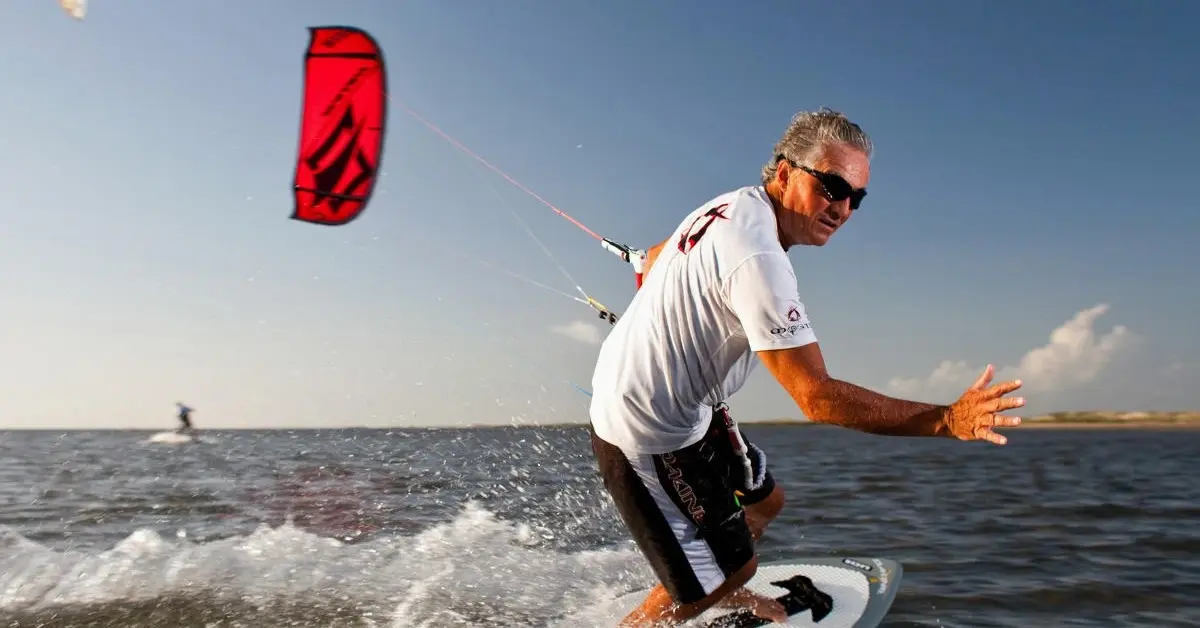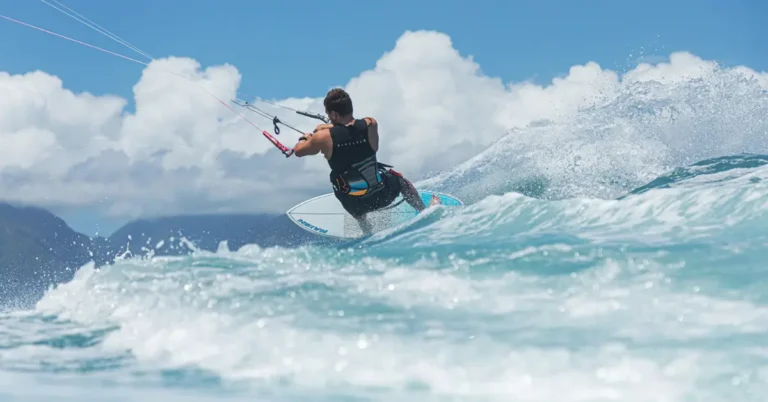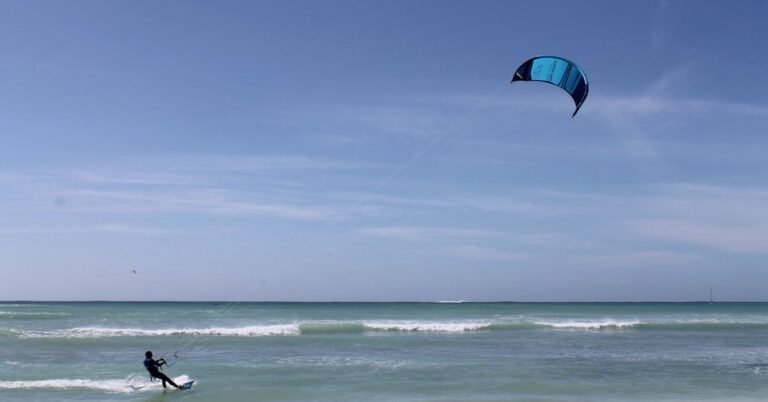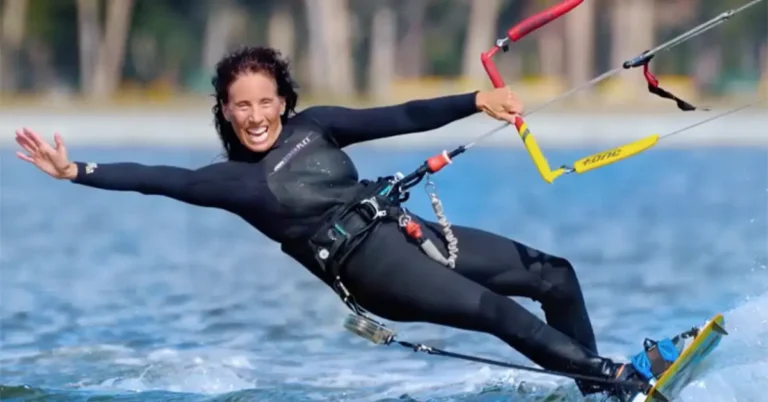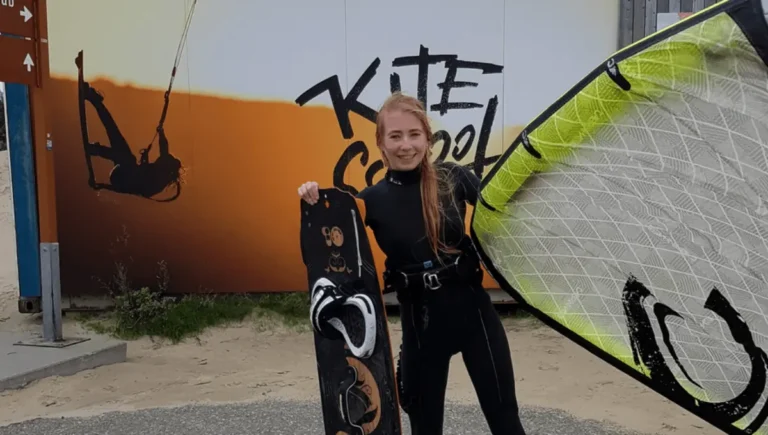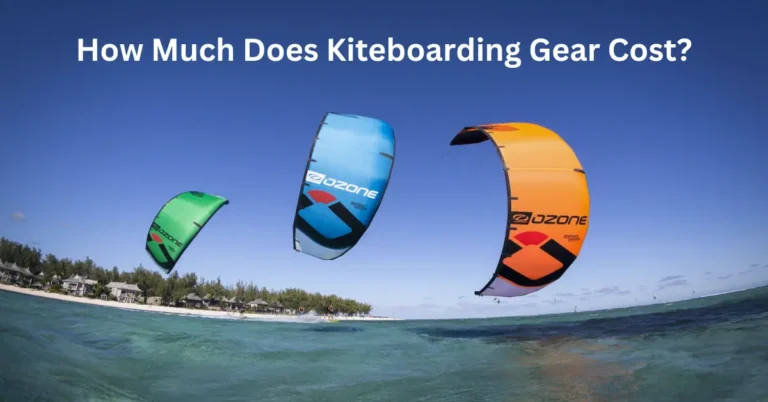Kitesurfing for Beginners: 5 Best Steps for Super-Fast Progression
Kitesurfing is booming worldwide because it’s exciting, easy to pick up, and loads of fun! While it might feel tricky at first, you’ll advance rapidly from being a total newbie to enjoying yourself on the water.
But remember, it’s crucial to learn with the proper equipment (like the right kite, board, and harness), at a safe location, and with a certified instructor. That way, you’ll have the best experience and stay safe while having a blast riding the waves!
Also Read: Size Kitesurfing Harness
5 Essential Steps for Super-Fast Progression For Kitesurfing
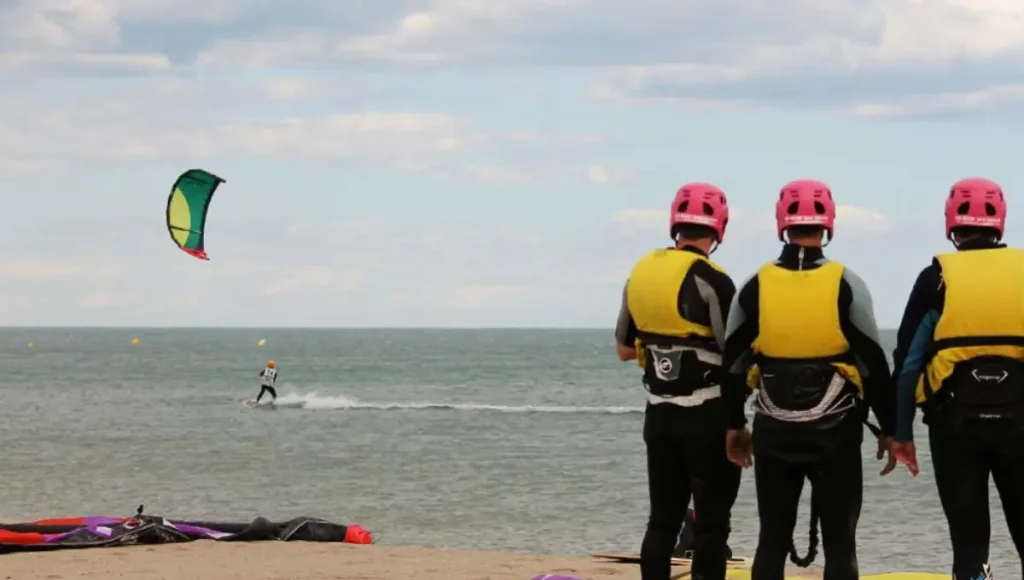
Check out this easy 5-step plan to speed up how quickly you get better at kitesurfing. It helps you save money by skipping lessons you don’t need and makes the early learning stages less frustrating.
Step 1: Learn To Fly a Trainer Kite
A trainer kite is a small kite, about 2 to 3 meters in size, that helps you learn kite flying safely before trying it on the water. It’s smooth and stable, making it easy to control and understand how kites work. You’ll learn about the wind and power zones, which are important for kitesurfing.
These kites usually have 2 or 4 lines, but some have 3 for safety. A 3 m2 kite is good for learning, but be careful in strong winds because even small kites can pull you or lift you off the ground.
By practicing with a trainer kite before your kitesurfing lessons, you’ll save time and money. Plus, you can use it for other activities like mountain boarding or snow kiting, or share it with friends.
Step 2: Dig Out Your Old Skateboard
Learning other board sports like wakeboarding, skateboarding, surfing, and snowboarding can greatly help you with kitesurfing. Being skilled in these sports means you’ll feel more comfortable on your kiteboard. This lets you focus more on controlling the kite rather than worrying about balancing on the board.
Among these sports, wakeboarding is the closest to kitesurfing because the boards are very similar. So, head to a cable ski center nearby and practice riding a wakeboard. It’s a great way to speed up your progress during kitesurfing lessons.
Step 3: Watch Some Instructional Kitesurfing Videos
To speed up your learning process for kitesurfing, watch as many instructional videos as you can. They’re super helpful when you’re ready to take lessons. There are plenty of good videos online that teach you the basics.
I recommend the Progression kitesurfing series, which has 5 videos from beginner to professional levels. You can get them on DVD or download them digitally. You can access useful videos on platforms like YouTube as well. But remember, videos are not a replacement for professional kiteboarding lessons.
The Progression Sports video series aims to prepare you before your lessons or refresh what you’ve already learned.
Step 4: Get Some Kitesurfing lessons from a Qualified Instructor
Make sure not to skip this step! Taking lessons from a certified kitesurf instructor is the best way to advance quickly and safely. If you’ve followed the first 3 steps in this guide, you’ll reduce the time needed for teaching by a lot.
Usually, a 3-day course with 4 hours per day will have you riding confidently. An instructor can quickly correct mistakes and prevent bad habits from forming.
Kitesurfing lessons are divided into stages to help you progress and learn the skills and knowledge needed to enjoy the sport safely.
Introduction And Equipment Setup
In the beginning, you’ll get familiar with all the kitesurfing gear: the kite, control bar, lines, harness, and board. Your instructor will show you what each part does and teach you how to set up and check everything properly.
Safety is key, so you’ll learn to inspect the gear for any issues like knots or tangles in the lines, and make sure your harness fits correctly.
Beach Piloting Aan Safety Precautions
Before heading into the water, beginners learn the basics of flying the kite on the beach. This includes understanding the wind and how to safely launch and land the kite. Once you’ve got the kite up in the neutral position, you’ll practice moving it around and controlling it in and out of the power zone.
Safety is a priority, so you’ll also learn to keep a safe distance from others on the beach and understand wind conditions. Once you’re comfortable with launching, landing, and controlling the kite in a figure-of-eight pattern, you’re ready to start kitesurfing in the water.
Kite Control And Body Dragging
Once you grasp the basics of kite control, you’ll advance to flying the kite in shallow water and learn to harness its power. By maneuvering the kite in and out of the power zone, you’ll begin to understand its force and use it to move yourself through the water.
Eventually, you’ll progress to body-dragging, where you learn to pull yourself upwind using the kite. This stage is crucial and forms a foundation for your further progress in kitesurfing.
Water Re-Launch And Self-Rescue
If your kite crashes into the water, it’s important to know how to relaunch it. You’ll discover how to maneuver the kite’s front edge out of the water and return it into the wind. With a small adjustment on the control bar, you can get the kite flying again.
If you can’t relaunch due to tangled lines or other problems, self-rescue techniques are vital. You’ll use the kite as a flotation device and do controlled body drags to retrieve your board and return safely to shore.
Introduction To The Board
As you improve in controlling the kite on the water, you’ll begin to use the board. You’ll learn to place the board under your feet while keeping the kite directly overhead. Once set up like this, you’re ready to try your first water start.
Water Start And First Board Ride
Once you’re confident with your body dragging and comfortable on the board, it’s time for your first ride. Your instructor will help you get on the board, use the kite’s power to control speed, and keep your balance while riding on the water. This is a big step in learning to kitesurf and an exciting moment for beginners.
Riding And Staying Upwind
Mastering riding and staying upwind marks the transition to advanced kitesurfing. You’ll coordinate kite and board control to glide smoothly on the water, riding across and back to your starting point.
Learning to stay upwind lets you explore open water freely. It involves positioning the kite correctly and adjusting your body on the board. Staying upwind enhances your kitesurfing experience and opens up new spots to explore.
Kitesurfing is risky without proper respect. Mishandling a 12m kite can lead to accidents. Getting lessons is crucial for safety. Kite schools provide suitable gear for different conditions and skill levels.
Step 5: Buy Kitesurfing Gear Adapted To Your Level And Local Conditions
When you start, expect to crash the kite – it’s normal. Practice with a tougher trainer kite before using the school’s gear. It’s likely to take a beating, so it’s smart to get lessons before buying your own.
After lessons, ask the school about second-hand gear for sale. They might offer a good deal. When you’re new, buying brand-new gear is almost pointless, as it will likely get damaged quickly.
How Fit Do I Need To Be To Kitesurf?
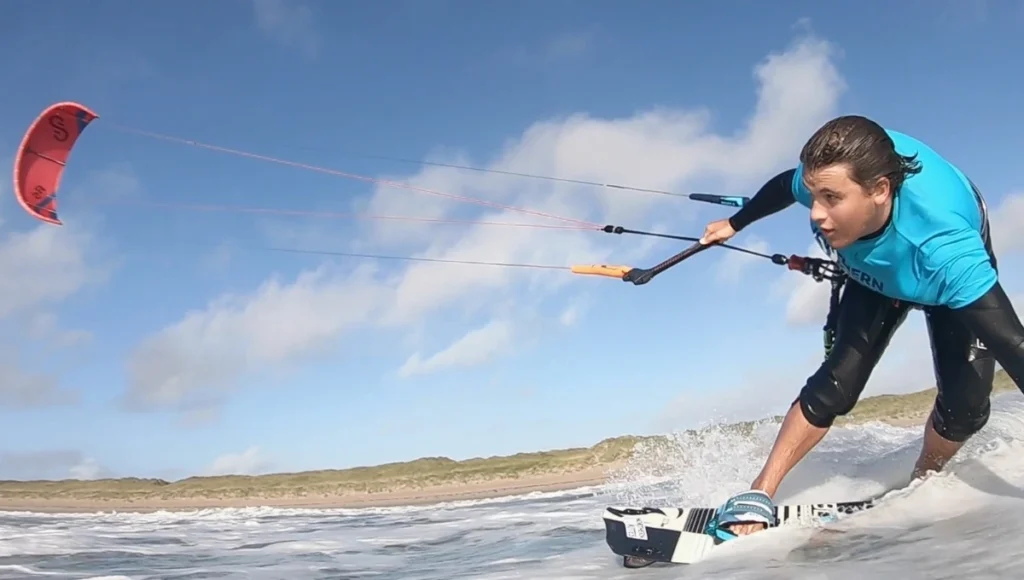
You don’t have to be super strong to kitesurf. Kids as young as 10 can do it! Girls, don’t worry about needing big muscles. With the right kite, almost anyone can kitesurf. It’s not your arms doing the work, it’s your core. But you should still be comfortable in water and have a decent fitness level.
How Much Does It Cost To Get Into Kitesurfing?
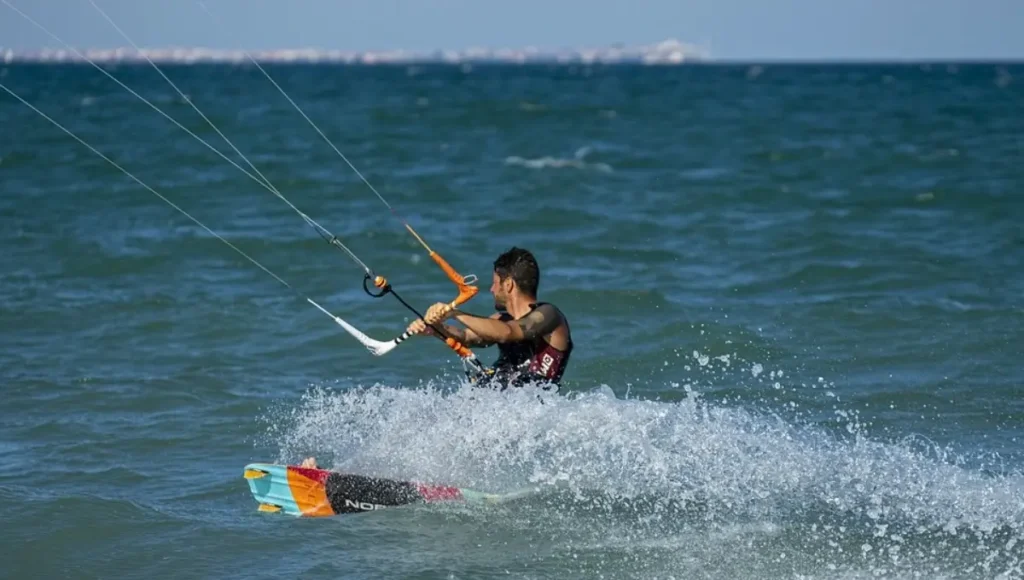
To start kitesurfing, you’ll need a kite, bar and lines, harness, and board. Buying new gear can cost around 1500 to 2000 GBP / 1700 to 2300 EUR. You can save money by buying previous year’s models at a discount of 30 to 40%.
Second-hand gear is also available, costing around 500 GBP / 580 EUR. Be aware of the kite’s manufacturing year, as older kites may lack safety features and be harder to use. You’ll also need a wetsuit, booties, helmet, and buoyancy aid, costing about 250 to 300 GBP when bought new.
For learning, a 3-day kitesurf course is recommended, costing around 290 GBP / 330 EUR. This includes 4 hours of tuition per day and all necessary gear.
How Long Does It Take To Learn How To Kitesurf?
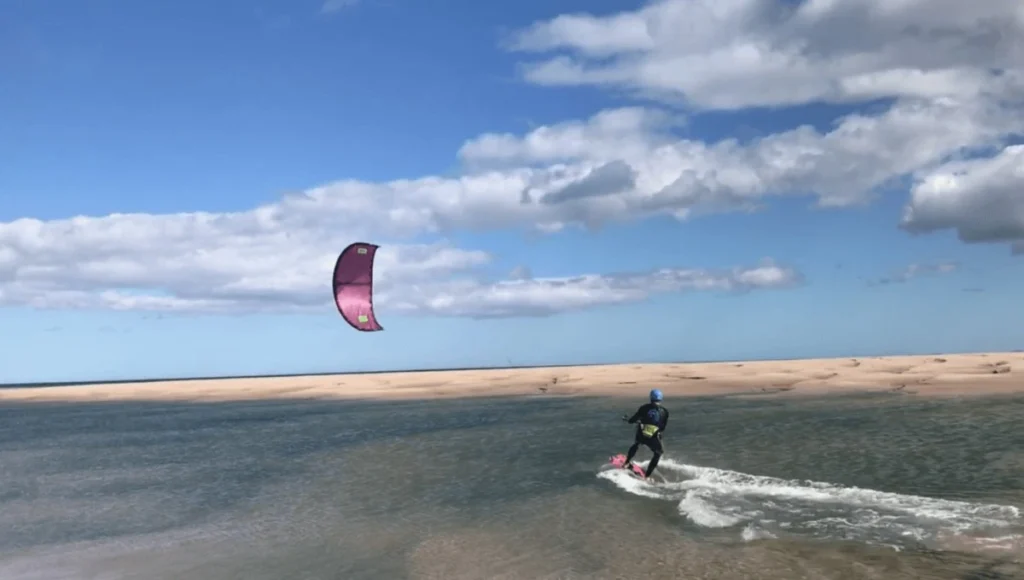
You can gain confidence and start riding in just 3 days. Kitesurfing is easier than it seems. If you’ve flown a power kite or tried activities like skateboarding, snowboarding, or wakeboarding, you’re halfway there.
A 3-day course with 4 hours of training each day should have you riding confidently. After that, practice as much as you can to improve your skills and feel comfortable riding upwind. Riding upwind helps you stay safe, avoid hazards, and return to where you started.
Extra Tip: Plan To Learn Somewhere That is Similar To Your Local Spot
Choosing the right kitesurfing school can be overwhelming with so many options. Consider where you’ll kitesurf most of the time. Pick a school with similar conditions. Check if they’re affiliated with the International Kitesurfing Organisation (IKO) or national bodies like BKSA or FFVL for safety standards.
IKO-affiliated schools ensure insurance and teaching quality. Check their affiliation on the IKO website. Stick to affiliated schools for safety. Choose a school that ensures safe, quick, and enjoyable learning, giving you the best chance to progress.
Frequently Asked Questions
Conclusion
Kitesurfing offers an exhilarating experience for beginners willing to take on the challenge. By following the five essential steps for super-fast progression, newcomers can quickly build their skills and confidence on the water. From mastering kite control to riding confidently, each step brings beginners closer to enjoying the thrill of kitesurfing.
With proper instruction, practice, and dedication, anyone can become proficient in this exciting sport. Remember, safety is paramount, so always learn from certified instructors and prioritize safety gear. Embrace the journey of learning to kitesurf, and prepare for an adventure-filled ride on the waves.
